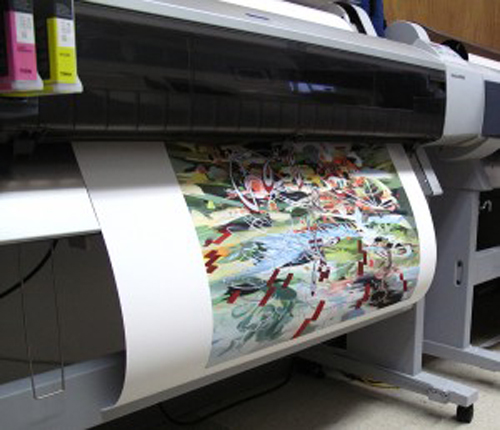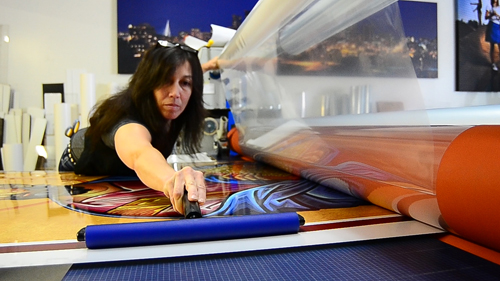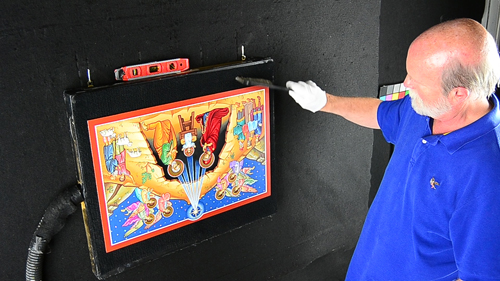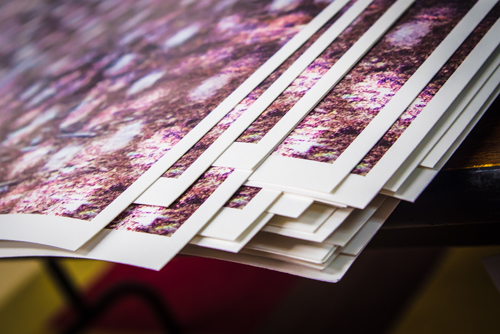by Carolyn Edlund
An interview with Michael Baker of fine art printing company Reed Art & Imaging shares insights and answers about reproductions, how they’re made and the benefits for artists.

AS: What are common misperceptions that artists have about fine art reproductions?
MB: Here are some top misperceptions that artists have, with explanations that tell the real story:
Misperception: Profiles are all that’s needed to get a good reproduction.
Reality: Color management is not a perfect science. Every artwork is unique and contains subtleties that the remaining percentage could be missing. These subtleties affect viewer perception, mood, emotion, etc.
Color management’s goal has always been to achieve better consistency from the same file printed across multiple devices with some level of predictability. The goal as a system is consistency and predictability — never was the goal to achieve the BEST print.
Software is a tool, but it doesn’t replace the experienced eye. It’s about achieving an edition that feels more like the original.
Misperception: All printmakers are the same.
Reality: Fine Art Printmakers come with varying levels of skill and technique. At one end are the budget focused printers who use a strict color-managed workflow with zero operator intervention. It’s inexpensive, because it’s done with every cost cutting measure they can get away with. It’s all about getting it out cheaply at “good enough” quality.
At the other end of the spectrum are the boutique printers like Reed Art & Imaging. A premier artist seeks out a boutique printer because they see and understand the differences it can make in their career, the difference between a cheap print and one produced by a master printer. Boutique print houses hire top grade master printers with the proper fine art experience. Software can get us only so far; the rest requires artisanship.
Misperception: Anyone can take a picture of my art.
Reality: Not being able to see an issue with a digital capture, or for that matter the print, does not mean the issues aren’t there. It’s possible the viewer just hasn’t developed the necessary experience to know what to look for beyond how the colors on the monitor compare to their original.
Editions are an investment towards the artist’s future business, so they may want to give that investment the best chance for success. Since the digital capture of the artwork is the very first step towards a quality reproduction, all aspects of the photographic process will affect the final print quality. That capture should be performed by a professional who has a full grasp of color theory, polarization, lighting, etc. It takes artisanship to get the very best outcome.
Misperception: Reproductions devalue my work.
Reality: To various degrees, this is both true and false depending on how you assign value. Is your primary market collectors of original one-offs? Are you looking at the value of your art as just the one-time sale of the original, or are you including the sales potential of the edition too? Artists use reproductions as a way to maximize the financial return on the work and materials invested in their original work.
If the artist’s primary collectors purchase works that are one of a kind, reproductions should be carefully considered. I would recommend they consult with art sales professionals and gather a few opinions before making a decision.
Misperception: Since they are not originals, I must sell them cheaply – they’re not worth my time.
Reality: It’s my opinion that reproductions can sell for prices attractive to the artist, the gallery, and the buyer. We have very successful clients who augment their editions so that each and every one is worked to some level by the artists hand, thus making each unique. Some of these reproductions sell into the four-figure range.

AS: What options and substrates do fine art printers offer?
MB: There are so many options in technology and media. Most often, you will find that quality print making studios offer these electronic reproduction technologies:
- Pigment Giclèe on art papers and simulated photo papers, and canvas
- Chromogenic Latent Image (photographic paper imaged with laser or LED)
There are some vendors who insist that flatbed UV curable printing and dye sublimation qualifies as fine art because of its lightfastness. Currently, those technologies suffer from a lack of color fidelity that is achievable in pigment or chromogenic. Both technologies make good enough prints, but they lack the depth and realism that only happens with proper color fidelity. It may be recognizable, but what you are missing with low color fidelity is all the amazing tones and values that make the print more like the real thing.
You will find a vast array of presentation options available through many print studios. The usual framing services are commonplace. Face mounts to acrylic are amazing to look at, and if done properly will preserve and protect the art piece. Typical mounting options are GatorFoam, Aluminum, Aluminum Composite Material, Museum Board, and Acrylic Sheet. Non-archival options are often available such as MDF, PVC Sheet, Hardboard, Glued Bamboo Board, etc.
AS: Could you explain the steps in the printing process?
MB: Yes, the following will take you step-by-step:
- Every edition begins with some form of electronic capture of the original piece. This may be in the form of a scan, or a digital camera. Files are then carefully inspected at magnification to ensure sharpness, detail, and other correctness. Then, it’s ready for testing.
- Files are opened and again inspected to verify they meet the criteria necessary to create a great reproduction of that particular piece.
- A test print is imaged using the very devices and papers on which the edition will be run. This allows the master printer and the artist to properly evaluate the state of the file and the outcome of the edition. Having the artist involved in the proofing is ideal to ensure their artistic voice is involved in the process. Your print maker should be more than a vendor. They should be a vibrant and willing extension of you and your process.
- After the testing process has completed and the artist has approved the final proof, a reference print is printed and stored with the signed proof at the print studio as a guide print for future runs.
- Individual prints are trimmed to specification, inspected and thoroughly evaluated against the signed proof. Depending on the artist’s requests, the prints are slip-sheeted or bagged and then carefully packaged
- Certificates of authenticity, if requested, are printed, trimmed and readied with the final prints.

AS: How true are colors in reproductions overall?
MB: For accuracy to happen, the colors in the artwork have to be available on the device making the prints. The maximum level of saturation a printer can output for all of its colors on a given paper is called “gamut.” As long as a given color on an original is within the printer gamut, it should be achievable. If the color is outside the gamut, i.e. fluorescent pigments, some ultra-bright colors, etc. won’t be accurate. They’ll just be as close as is mechanically possible on the device.
The large majority of pieces we see from day to day reproduce very well. But the pigments in a reproduction are different than the media used in the original. The two may look spot on under one type of light, yet different under another.
When a print maker has access to the original art, it’s more likely that a satisfying reproduction can be made. If the art is in California and the vendor is in Colorado, the output becomes subjective. It’s very rare that what an artist sees on their monitor will match the vendors monitor, much less what comes off the printer. A color managed workflow is generally used.
Metallics, fluorescents, pearls, etc. don’t reproduce with current technology. The characteristics of translucency can’t be replicated with pigment on paper.
Some works have so many subtleties that acceptable matches become excruciatingly difficult. But most artwork that comes through our doors can be reproduced very close to the original. Factors involved in accuracy can include the papers chosen, and the inks used. The skills of the photographer capturing the original art plays a big role in the quality of the reproduction.
AS: What is the typical order/fulfillment cycle and how do you work with artists to help them run their businesses smoothly?
MB: The minimum cycle is usually in the 6-9 business day range. Working with your fine art print maker side by side can be time consuming, but the rewards are worth the efforts. A good print studio will get to know you, your style, and your preferences.
Print studios are also at the mercy of suppliers who are at the mercy of shipping companies and paper mills.
Working with your print maker should feel like you have a partner in your success, not like you are just an account number and a paycheck. When artists come in for a consultation, we want to be able to provide them with a print and presentation method that exceeds the minimum requirements and opens new doors of success for them.
Drop shipping and print on demand are the two most often cited benefits to working with a great print studio. Complete fulfillment means that the print or art piece is shipped directly to the buyer, gallery, or studio.

AS: What recommendations do you have for artists who are interested in working with a fine art printer, but are just getting started?
MB: Be patient with yourself as you learn. There will be frustrations along the way.
Use a vendor that respects you and your print needs.
Find one that will work with you and offer options and solutions. These print makers will spend more time making your reproductions shine and will therefore be more invested in you and your career. Find a print maker that loves to co-create your success!
Make appointments for consultations. When you schedule your meetings with your business vendors ahead of time, you make it possible for them to be fully prepared when you arrive, and fully present in the meeting. While just dropping in is usually okay with most studios, appointments can allow you and their team to best leverage the limited time on your behalf. Ask questions to stay up to date with current trends and technologies in the fine art print market.
Most artists I know LOVE to talk about their passion!


That’s a fine article for an artist to know the reality. These misperceptions are everywhere between them
I’d be interested to hear more about the pros and cons of limited edition versus open edition and signed versus unsigned. I use a local printer so that I can check, sign and number my prints. If you use an online print fulfillment service you can’t do any of those things and the print that gets sent direct to your customer could vary in quality.
Many artists used limited editions to increase the price of the product, and to create urgency, since there are, of course, a limited number of prints available. Printmakers truly make limited editions due to their process, but the concept has evolved as a sales strategy for all types of prints. And, you may be able to get a higher price. But if your print is popular and you sell out, how many more could you have sold? Are you actually restricting your income?
Signed is always preferable to unsigned, and an original signature is best. You will not be able to offer that with print on demand unless they ship to you, you sign them and you ship to the customer, which is an expensive hassle. And yes, you do risk a variation in quality unless you see the prints in person. I imagine the best you could do with a POD provider is order one of each print yourself to see the quality of their work.
Thanks for those thoughts on the subject Carolyn. I’ve been selling signed limited editions of 100 for a few years now and the price has increased over time. But soon my most popular prints will be sold out. I wonder sometimes if I should reserve some good new images for open edition to ensure a future income. It’s hard to change once you’ve established a precedent!
I can appreciate your dilemma, Rebecca. You don’t have to only offer limited editions. I agree with you that when you do this, you could be limiting your income, especially with particularly popular images. Why not try some open editions at a similar price and see how they do? It may not be that the “limited” nature of the art is what is creating interest, but that your audience just loves your work.
Thanks for that, Carolyn. I never would’ve thought to offer them at the same price. I just assumed that it’s well established in the art world and the public imagination that signed limited edition is higher value. I’ll have to turn that over in my mind for a while!